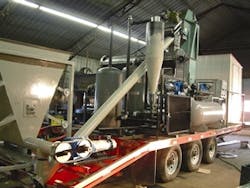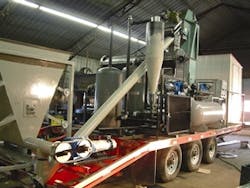New Route Beckons for Key Feedstocks
Low-cost pyrolytic bio-oils -- made from waste wood, agricultural waste and non-food energy crops -- may displace petroleum as a feedstock for making chemicals such as benzene, toluene, xylenes and olefins, say a team of chemical engineers at the University of Massachusetts Amherst, Amherst, Mass. The researchers have developed a two-step process that significantly improves the conversion of the pyrolysis oils.
"In the past, these compounds were made in a low-yield process," says George Huber, an associate professor at the school. "But here we show how to achieve three times higher yields of chemicals from pyrolysis oil than ever achieved before. We've essentially provided a roadmap for converting low-value pyrolysis oils into products with a higher value than transportation fuels."
"Thanks to this breakthrough, we can meet the need to make commodity chemical feedstocks entirely through processing pyrolysis oils," he adds. "We are making the same molecules from biomass that are currently being produced from petroleum, with no infrastructure changes required."
Huber and doctoral students Tushar Vispute, Aimaro Sanno and Huiyan Zhang use a two-step, integrated catalytic approach to make the aromatics and olefins. They start with a "tunable" variable-reaction hydrogenation stage followed by a zeolite-based catalytic step. The zeolite catalyst boasts suitable pore structure and active sites to convert biomass-based molecules into aromatic hydrocarbons and olefins. More details appear in a recent paper in Science.
The olefins-to-aromatics ratio and the types of olefins and aromatics produced can be adjusted to suit market demands, note the researchers. For instance, changing the temperature, the recycle ratio and the catalyst allows fine-tuning of the olefins-to-aromatics ratio.
So, producers should be able to tailor operations to produce carbon content from biomass they need. Huber and colleagues provide economic calculations for determining the optimal mix of hydrogen and pyrolytic oils, depending on market prices, to yield the highest-grade product at the lowest cost.
The team currently is scaling up the technology to make liter quantities.
"We are also developing computational models using sophisticated chemical engineering tools that will enable us to rapidly [and] efficiently scale up from the bench top to commercial plant. These models have all of the chemical and physical information about what is happening in the reactor," says Huber.
The team is also trying to make the process more economical by designing more efficient catalysts and reactors that will lead to higher yields.
Huber notes the limitations of the technology are directly related to economics and competing with petroleum. Ideally, Huber and his team hope to produce chemicals that can compete economically with those derived from petroleum oil at oil prices of $30 per barrel.
Huber expects the process to become commercially available in the next 5 years.

